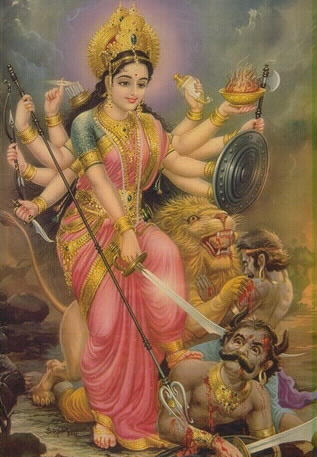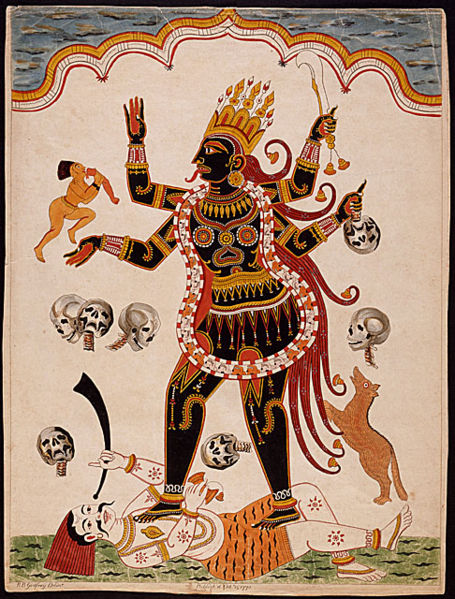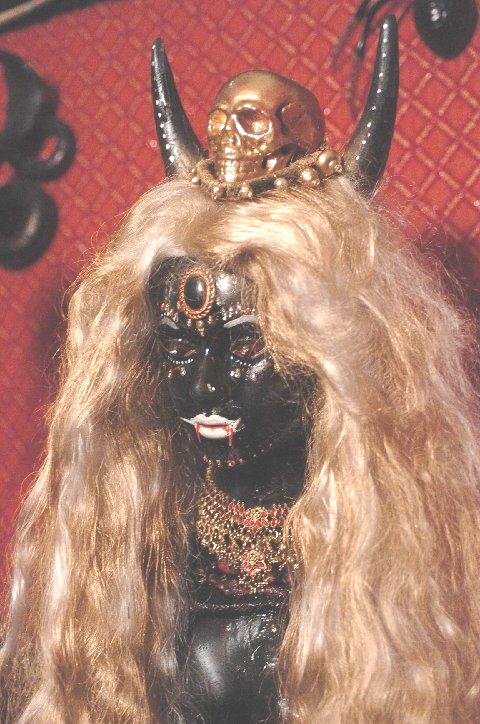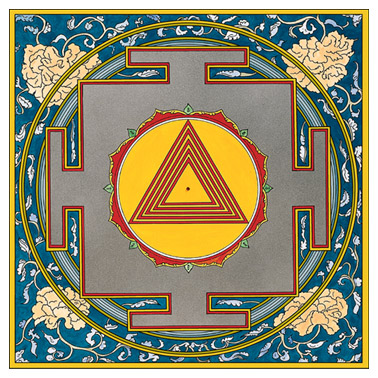
Devi Mata - Shaktism
Markandeya Purana is one of the 18 Maha Puranas;
it glorifies the Great Mother - Devi Mata as the principle of creation,
maintenance, and cremation of the universe. 700 verses from Markandeya
Purana - Devi Mahatmyam (also known as
Durga Saptashati or Chandi) is a very important text for the shaktas.
Other important text is Srimad
Devi Bhagavatam.
I optically recognized Markandeya Purana and it is here available for
download as quality spell-checked text (translation by F. E. Pargiter,
1904). Devi Mahatmyam (Chapter 81 in Markandeya Purana) is also in
the book. Download it here.
A
beautiful slideshow of Mother Goddess.
In Poland, there is a Black
Madonna in church in the city of Czestochowa. Why is She black?
Reports from centuries ago speak about miraculous events - of healings
occurring to those who made a pilgrimage to the portrait. On the mountain
called Montserrat in Spain (near Barcelona) there is another church
with a 'miracle-working' statue of the Madonna and Child
known as La Moreneta, that is: the dark little one.
The Chapter 2 of Devi
Mahatmyam describes the materialization of the Infinite
Female Divinity:
In former times war was
waged between the deities and demons for the full space of one hundred
years; also between Mahishasura, the greatest of demons, and Poorunder
(the greatest of deities).
The Asura of ample heroism repulsed the
army of the Devas; Mahishasura vanquished all the angels and became
as Indra.
After this, the conquered deities went with
Prajapati whose abode was the lotus to Garuda-dhwaja (or the eagle
bannered).
The Tridasas laid before him the distress
of the gods with an account of Mahishasura's actions.
That he had usurped the authorities of Surya,
Indra Anila, Indu, Yama, and Varuna; and others himself.
They said, the gods are oppressed by the
ill disposed Mahisha; the whole multitude of Devas have left heaven
and wander on the earth like mortals.
Those are the deeds of the enemies of the
immortals, we humbly bow to thy asylum to meditate on their death.
Madhusudana (Vishnu) hearkened to the words
of the deities; Sambhu (Shiva) was wroth contracting his brows with
furious ire.
Afterwards, Chakrini's face was transported
with rage, abundance of light issued from Brahma and Sankara.
An immense mass of light proceeded from
the bodies of Sakra and all the other Devas, and conglomerated.
This effulgent lustre appeared as a flaming
mountain: the Suras having seen the flame receded to the extremities
of regions.
The peerless light issued from the bodies
of all the Devas and the phenomenon was transfigured as a woman extending
through the three worlds.
The energy of Siva created her face; the
brightness of Yama made her hair; her arms were formed by the light
of Vishnu.
Her two breasts were made by the Moon; the
space between them by Indra; her thighs and the calves of her legs
by Varuna; her loins by the light of Bhuvi.
Her feet by the energy of Brahma; her toes
by the rays of the sun; her fingers by Vasus, her nose by Kubera.
Her teeth were created by the brightness
of Prajapati; her three eyes by the energy of Pavaka.
Her forehead by the light of Sundhia; her
ears by Anila; the brightness of other deities formed her body.
From the glory of the light of all the Devas,
Siva sprang; the Amaras perceived the destroyer of Mahisha and exulted.
Shaktism
is a denomination of Hinduism in which devotees worship Shakti
(the Divine Mother) in all Her forms.
In pure Shaktism, the Great Goddess, or Mahadevi,
is worshiped as nothing less than the Highest
Divinity.  The presently known Shaktism developed
between the 4th and the 7th centuries CE in India, but many of its
forms had started much earlier when aboriginal people had worshipped
female attributes of nature. Followers of Shakti are called
Shakta. Shaktism has a little non-Indian attribute - it contains
rites with features uncommon in all mainstream Hindu denominations.
Most Indians would never mix with other castes even today. The Shakta
worshippers, however, do not pay much regard to these caste distinctions.
Some scholars and historians therefore think that such an attitude
had originated in aboriginal cultures (with matriarchal society) and
Hindus adopted it later.
The presently known Shaktism developed
between the 4th and the 7th centuries CE in India, but many of its
forms had started much earlier when aboriginal people had worshipped
female attributes of nature. Followers of Shakti are called
Shakta. Shaktism has a little non-Indian attribute - it contains
rites with features uncommon in all mainstream Hindu denominations.
Most Indians would never mix with other castes even today. The Shakta
worshippers, however, do not pay much regard to these caste distinctions.
Some scholars and historians therefore think that such an attitude
had originated in aboriginal cultures (with matriarchal society) and
Hindus adopted it later.
Parvati
Parvati
is the reincarnation of Sati,
the first Shiva's wife. Sati,
the daughter of an ancient god - Daksha (in Satya Yuga), had
chosen to marry Shiva. Daksha disapproved
this because for him Shiva was rather a paradoxical
ascetic character associated with animals, ash, snakes, and ghosts.
One day, Daksha held a big religious sacrifice (yagna) and
invited all the gods, but not Sati and
Shiva. However, Sati came, uninvited, to look at
sacrifice rituals, but after hearing her father's sharp and ridiculing
words in direction of Shiva she threw herself into the ritual
pyre. (This is the root of the custom
known as "Sati" - when
widowed women ended their life alive on the funeral
pyre with their deceased husbands - which appeared in India.)
When Shiva found out what happened,
He destroyed the yagna and killed Daksha.
Shiva then took the Sati's corpse
on His back and ran fiercely all around the world demolishing everything.
Lord Vishnu wanted to stop Shiva
and used His divine discus to
cut the Sati's body into pieces in order to mitigate the Shiva's
outrage. The chopped off pieces of the
Sati's body fell down on Earth (on various places) and
the spots they fell onto are today known as Shakti
Peethas. Shiva is believed to be guarding each of
these Shakti Peethas in His fiercest
form known as Bhairava. Parvati
is the incarnation of Sati and She is the Shiva's
second consort and the Mother of Ganesha
and Skanda.
Who
is Kali - the skull Goddess?
Kali is Mother
Divine in Her fiercest form.
This vicious form of Shakti has
the absolute supremacy over evil
- that is, over attachment of matter (ego)
to matter. Goddess Durga
created Her as a form of Supreme Goddess.
Kali has also Her ghost sister - Coatlicue
- the Azetc Goddess also called Teteo
Inan (Mother of Gods) pictured with a garland of dismembered human
hands, hearts and skulls.
Kali is depicted wearing
garlands of human skulls and dismembered parts
of bodies, which may often give a wrong impression that She
is an evil form of God. Ideas, beliefs and history, too, may be easily
deformed - does it imply that Christians are racists only because
Ku Klux Klan members bow to their cross? Any god can be strangled
with the same burning cloak within the fumes of which superstitions
and misconceptions can only prevail. 
Kali is destruction
(death) of time and matter, She does not bring death to innocent persons.
The crucifix represents the Christ's
victory over death (matter). Kali
with skulls gives us the same message. The dismembered
parts of human bodies in Her hands only symbolize the transience
of the material world. It is our ego
which gets always attached to the material world and Kali's fierce
depictions simply show importance of destruction of ego's attachment
to the body (matter to matter dependence), not
really physical death.
Perception of Kali was also deformed in
India by several cults; one of them was the so-called "thugee"
cult, which traced its origin to seven Muslim tribes. No one
knows when the cult had started, but the first authenticated record
originated in about 1356 AD. Some
historians say that - even though thugees
did really exist - British colonists blew
up this story with purpose to justify executions of their
adversaries. Kali in the thugee cult had allegedly
a robust resemblance to Muslim Fatimah,
the youngest daughter of the Prophet. This information comes
from British officers (who unveiled this during their interrogations
and executions).
Deformation of Kali also comes from superstitions
and the way the Western media
present them - a man in Nepal, for example, cut off his hand and dedicated
it to Kali. Something similar, too, happens every year in the
Philippines when "followers of Christ"
get publicly crucified before the eyes of thousands of followers
and visitors. The effects of crucifixion,
when a fake "Christ"
is flogged until his skin and flesh hang
down in shreds, may easily result in severe health problems
or even death, but the Western media present such "Christs"
and Christianity in two separate sleeves only. On the other hand,
if there is any link to anything bad in relation to Kali or
any other Hindu God, the media almost always associate Hinduism with
it. Islam, too, is not an exception.
Hollywood "horrors" depict DEVILS
always regrettably more powerful than God,
and they, too, always like to depict Kali as devil only. Is
it because of this brainwashing most people, when they look at Kali,
think they see a demon instead of a God?
The medieval European Inquisition
(under the supreme power of Christians) used practices of the most
unthinkable forms of torture -
for example, pouring red-hot lead into the
vagina with other sadistic "exercises". It appears
that white civilization does the same thing even today, but with "psychological
forms of torture" (like giving us false values, false views,
etc.).
A very important aspect of Kali worship
is Kali Puja - the Night of Kali.
It occurs on the night (in the lunar calendar) when the veil between
the light and darkness is the thinnest - the dark
moon. Every night when the
dark moon or Amavasya occurs may
be considered as the Night of Kali, but
Kali Puja (or Pooja) is a
special day that coincides with the first day of Diwali (the
Festival of Lights in India) in Bengal, where Kali is the presiding
deity; in other parts of India it is Lakshmi (a consort of
Lord Vishnu). Diwali comes in the month of October or November (Kartik)
and its date is based upon the lunar calendar (dark moon). In 2007,
it was on 8th/9th November (some calendars differ in this respect).
The purpose of Kali Puja is to diminish our ego and everything
that hinders our spiritual growth. Kali's most famous temples
are in Kalighat
(Bengal, India) and Dakshineshwara (Bengal, about four miles
from Calcutta).
Kali, clad in tiger's
skin, is black, sometimes dark-blue.
Her possessions are veneered with skulls; temples and personal things
too. Accepting Her blackness and skull-like omnipresence means
that we - the terrestrials living in duality, must unconditionally
subordinate to the Oneness of God.
A famous Bengali mystic and poet - Ramprasad
Sen (1720-1781), wrote superb poems showing zealous devotion to
Kali. Another famous follower of Kali
was Sri Ramakrishna Paramahamsa.
Kali has many names like Maha
Kali (or Kaali), Nitya Kali, Smashana
Kali, Raksha Kali, Kalikamata, Kalaratri, Vyaghracharmavrita (wearing
tiger skin), Elamma or Kottavei
(Tamil). She is depicted with eight arms, but also with two
or four arms, of which the latter is most commonly seen. Occasionally,
you can also see Her with ten or eleven hands. Of the Puranas,
the Kalika Purana (Upa Purana)
is the most important work for the Kalika (Kali) worship. However,
Shaktas do not consider Kalika Purana or Devi Bhagavatam
to be "Upa Puranas" - they say that the mainstream vaishnavism
and shaivism made this division.
Kali was also observable in Caledonia, which
is a Latin word the Roman Empire used for the northern part
of the present Great Britain - an ancient Caledonia tribe lived here
and worshiped their black Mother Goddess - Caillech.
A Finnish goddess of death, Kalma,
lives allegedly in the underworld. In the Slavic
mythology we have Nav
- the fearsome goddess of death, but also Chernobog - a black
god (goddess).
Kali, if approached with love and open arms,
promises unconditional love to
Her devotees regardless of race or sexual orientation. She does not
care about social status either. Her blackness is the power
that absorbs everything - that is, all dualities will cease. She is
beyond time. Kali is therefore ONE and She wants to
keep it that way.
The ultimate truth is that if you want to
come nearer the things you cannot usually see, the sunniest
daylight in a hypocritically happy and smiling world is
not always the correct passageway to secret
castles that hide the most opulent treasures.
AUM KRING KALIKAYE NAMAH
AUM
Mahavidyas (Great Wisdoms) are
aspects of Mother
Devi. The Ten Mahavidyas
are known as Wisdom Goddesses
(Cosmic Personalities) and the following names may differ according
to local customs and traditions: Kali, Tara,
Tripura Sundari, Bhuvaneshvari,
Bhairavi, Chhinnamasta, Dhumavati, Bagalamukhi,
Matangi, and
Kamalatmika.
There are
also nine forms of Shakti/Durga worshipped
during Navaratri, which is a Hindu festival. The word Navaratri
literally means nine nights in
Sanskrit and this festival takes place in memory of the Durga's
victory over the demon Mahishasur.
Nine aspects of Mother Divine (Shakti):
* Durga, the inaccessible
one
AND HER ASPECTS
* Dhumavati, eternal widow
* Bhadrakali, a gentle Kali
* Amba or Jagadamba, Mother of the Universe
* Annapurna, The One who bestows grains
* Sarvamangala, The One who gives joy (mangal) to all (sarva)
* Bhairavi, a fierce and terrifying form of Shakti
* Chandika or Chandi, Supreme Goddess
* Lalita, The One who plays
* Bhavani, a fierce aspect of Shakti

Dhumavati
is a form of Sati
- the first Shiva's consort. There is a story that Sati once became
very hungry and swallowed Shiva. After disgorging Him, Shiva then
cursed Sati - she had to assume the form of a widow - Dhumavati. Her
formidable appearance has nothing to do with "demons"; it
only wants to indicate that even the greatest demons, after seeing
this form of Mother Devi, will run away
in fear.
The names (aspects) of Nine-Form
Durga (Nav Durga) differ and here is another list:
Durga Shailputri (Daughter
of Mountain)
Brahamcharini
Dhumavati
Chandraghanta
Skanda Mata
Kushmanda
Kaalratri
Maha Gauri
Siddhidatri
The above aspects, including
Durga alone, have a significance
for particular days of Navratri.
Tantra
Followers of Shakti
are allowed to eat meat (not beef) and drink wine. They have the so-called
Panchatattva Ritual - one niche of Shaktism, which is still
nowadays practiced in Bengal. "Panchatattva" is a term derived
from two words: "Pancha", meaning
"five", and "Tattva", meaning "elements".
Panchatattva is a ritual during the magic of which its practitioners
absorb the energy of the following five elements of nature ("five
M's"): mamsa (meat), matsya (fish), madya
(alcohol), mudra (parched grain), and maithuna (sexual
union). Tantric sects can be classified as either left-handed
(vamachara), or right-handed (dakshinachara,
also known as samayachara). Tantrism is a secret path and if Shakta
followers participate in the "five M's" ritual (also called
the "cakrasadhana" ritual), many Hindus may identify this
as a left-handed worship even without being initiated into it. Partakers
of the left-handed path often do things which may appear obscene.
However, pure making of love is not obscenity. The doctrines and rituals
of Shaktism can be found in a special branch of Indian Scriptures
- Tantra Shastra. A viable esoteric path can only be based
upon guidance of wiser beings who know that Tantra is not for masses;
if it gets into the general public, it then degenerates.
Thus, a typical aspect of
genuine Tantrism is that it must
be kept secret. It has never gone public and it must be preserved
this way. New adepts of Tantrism in the regions where it has always
had a big tradition (India, Indonesia...) had to take an oath that
they would keep the Tantric knowledge secret.
Western Tantrism is aimed at running a flourishing business and at
gaining money. If anybody wants to spiritually advance this way, he
or she has already wandered into the tracks of blind alleys.
108 Names of Goddess Durga
1) Durga - The Inaccessible
2) Devi - The Deity
3) Tribhuvaneshwari - Goddess of The Three Worlds
4) Yashodagarba Sambhoota - Emerging From the Yashoda's Womb
5) Narayanavarapriya - Fond of Narayana's Boons
6) Nandagopakulajata - Daughter Of The Nandagopa Race
7) Mangalya - Auspicious
8) Kulavardhini - Developer Of The Race
9) Kamsavidravanakari - Threatened Kamsa
10) Asurakshayamkari - Reducer Of The Number Of Demons
11) Shilathata Vinikshibda - At Birth, Slammed By Kamsa
12) Akashagamini - Flew In The Sky
13) Vasudevabhagini - Sister Of Vasudeva
14) Divamalya Vibhooshita - Adorned With Beautiful Garlands
15) Divyambaradhara - Beautifully Robed
16) Khadgaketaka Dharini - Holder Of Sword And Shield
17) Shiva - Auspicious
18) Papadharini - Bearer Of Others' Sins
19) Varada - Granter Of Boons
20) Krishna - Sister Of Krishna
21) Kumari - Young Girl
22) Brahmacharini - Seeker Of Brahman
23) Balarkasadrushakara - Like The Rising Sun
24) Purnachandra Nibhanana - Beautiful Like The Full Moon
25) Chaturbhuja - Four-Armed
26) Chaturvakttra - Four-Faced
27) Peenashroni Payodhara - Large Bosomed
28) Mayoora Pichhavalaya - Wearer Of Peacock-Feathered Bangles
29) Keyurangadadharini - Bejeweled With Armlets And Bracelets
30 Krishnachhavisama - Like Krishna's Radiance
31) Krishna - Dark-Complexioned
32) Sankarshanasamanana - Equal To Sankarshana
33) Indradhwaja Samabahudharini - With Shoulders Like Indra's Flag
34) Patradharini - Vessel-Holder
35) Pankajadharini - Lotus-Holder
36) Kanttadhara - Holder of Shiva's Neck
37) Pashadharini - Holder Of Rope
38) Dhanurdharini - Holder Of Bow
39) Mahachakradharini - Holder Of Chakra
40) Vividayudhadhara - Bearer Of Various Weapons
41) Kundalapurnakarna Vibhooshita - Wearer Of Earrings Covering The
Ears
42) Chandravispardimukha - Beautiful Like The Moon
43) Mukutavirajita - Shining With Crown Adorned
44) Shikhipichhadwaja Virajita - Having Peacock-Feathered Flag
45) Kaumaravratadhara - Observer Of Fasts Like Young Girls Do
46) Tridivabhavayirtri - Goddess Of The Three Worlds
47) Tridashapujita - The Goddess Of The Celestials
48) Trailokyarakshini - Protector Of The Three Worlds
49) Mahishasuranashini - Destroyer Of Mahisha
50) Prasanna - Cheerful
51) Surashreshtta - Supreme Among The Celestials
52) Shiva - Shiva's Half
53) Jaya - Victorious
54) Vijaya - Conqueror
55) Sangramajayaprada - Granter Of Victory In The War
56) Varada - Bestower
57) Vindhyavasini - Resident Of The Vindhyas
58) Kali - Dark-Complexioned
59) Kali - Goddess Of Death
60) Mahakali - Wife Of Mahakala
61) Seedupriya - Fond Of Drinks
62) Mamsapriya - Fond Of Flesh
63) Pashupriya - Fond Of All Beings
64) Bhootanushruta - Well-Wisher Of Bhootaganas
65) Varada - Bestower
66) Kamacharini - Acting On One's Own Accord
67) Papaharini - Destroyer Of Sins
68) Kirti - Famed
69) Shree - Auspicious
70) Dhruti - Valiant
71) Siddhi - Successful
72) Hri - Holy Chant Of Hymns
73) Vidhya - Wisdom
74) Santati - Granter Of Issues
75) Mati - Wise
76) Sandhya - Twilight
77) Ratri - Night
78) Prabha - Dawn
79) Nitya - Eternal
80) Jyotsana - Radiant Like Flames
81) Kantha - Radiant
82) Khama - Embodiment Of Forgiveness
83) Daya - Compassionate
84) Bandhananashini - Detacher Of Attachments
85) Mohanashini - Destroyer Of Desires
86) Putrapamrityunashini - Sustainer Of Son's Untimely Death
87) Dhanakshayanashini - Controller Of Wealth Decrease
88) Vyadhinashini - Vanquisher Of Ailments
89) Mruthyunashini - Destroyer Of Death
90) Bhayanashini - Remover Of Fear
91) Padmapatrakshi - Eyes Like The Lotus Leaf
92) Durga - Remover Of Distress
93) Sharanya - Granter Of Refuge
94) Bhaktavatsala - Lover Of Devotees
95) Saukhyada - Bestower Of Well-Being
96) Arogyada - Granter Of Good Health
97) Rajyada - Bestower Of Kingdom
98) Ayurda - Granter Of Longevity
99) Vapurda - Granter Of Beautiful Appearance
100) Sutada - Granter Of Issues
101) Pravasarakshika - Protector Of Travelers
102) Nagararakshika - Protector Of Land
103) Sangramarakshika - Protector Of Wars
104) Shatrusankata Rakshika - Protector From Distress Caused By Foes
105) Ataviduhkhandhara Rakshika - Protector From Ignorance And Distress
106) Sagaragirirakshika - Protector Of Seas And Hills
107) Sarvakaryasiddhi Pradayika - Granter Of Success In All Attempts
108) Durga - Deity Durga
Back


